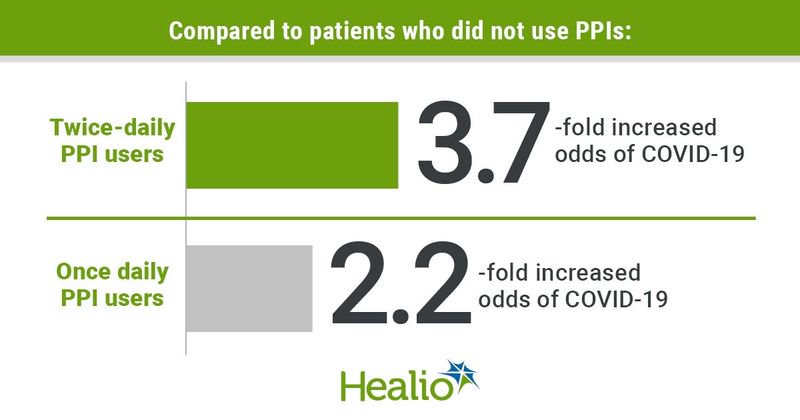Proton pump inhibitor use doubles risk for COVID-19
An independent, dose-response relationship was seen between proton pump inhibitor use and COVID-19 positivity, according to a study published in the American Journal of Gastroenterology.
“We found that PPI use, particularly twice-daily dosing, is associated with increased odds for reporting a positive COVID-19 test, even after accounting for a wide range of sociodemographic, lifestyle, and clinical variables,” Christopher V. Almario, MD, MSHPM, from the department of Medicine at Cedars-Sinai Medical Center in Los Angeles, told Healio Gastroenterology. “Our findings continue to emphasize that PPIs should only be used when clinically indicated at the lowest effective dose.”

Researchers performed a population-based, online survey of 53,130 patients from May 3 to June 24, 2020 to determine if PPIs increased the risk for COVID-19 among community-dwelling Americans. They used multivariable logistic regression to report on a positive COVID-19 test to adjust for confounding factors.


Of those surveyed, 3,386 patients reported a positive COVID-19 test. Investigators noted a significantly increased odds for reporting a positive COVID-19 test in patients who used PPIs either once daily (OR = 2.15; 95% CI, 1.9–2.44) or twice daily (OR = 3.67; 95% CI, 2.93–4.6) compared with those who did not use PPIs. An elevated risk was not seen among patients who took histamine-2 receptor antagonists (H2RAs).
According to researchers, 3,267 patients who tested positive were symptomatic and 647 patients said they experienced a new onset of abdominal pain, diarrhea and nausea/vomiting. Results from regression analysis demonstrated patients who took lower-dose PPIs (n = 266, 10.9%; OR = 0.62; 95% CI, 0.49–0.78) had a lower chance for reporting GI COVID-19 symptoms compared with patients not on PPIs (n = 297, 39.5%).
“This study does not mean that people on PPIs should just stop their medicines,” Brennan M.R. Spiegel, MD, MSHS, professor-in-residence of medicine and public health at Cedars-Sinai Medical Center, David Geffen School of Medicine at UCLA and UCLA Fielding School of Public Health, told Healio Gastroenterology. “PPIs work and, in most cases, their benefits outweigh the risks. As always, the decision about whether, when, and how to modify PPI dosing should be based on a thoughtful assessment of the risk-benefit ratio for individual patients. As with any medication, the lowest effective dose should be used when clinically indicated, and, when appropriate and consistent with best-practice guidelines, H2RAs may also be considered as an alternative treatment for acid-related conditions.”


